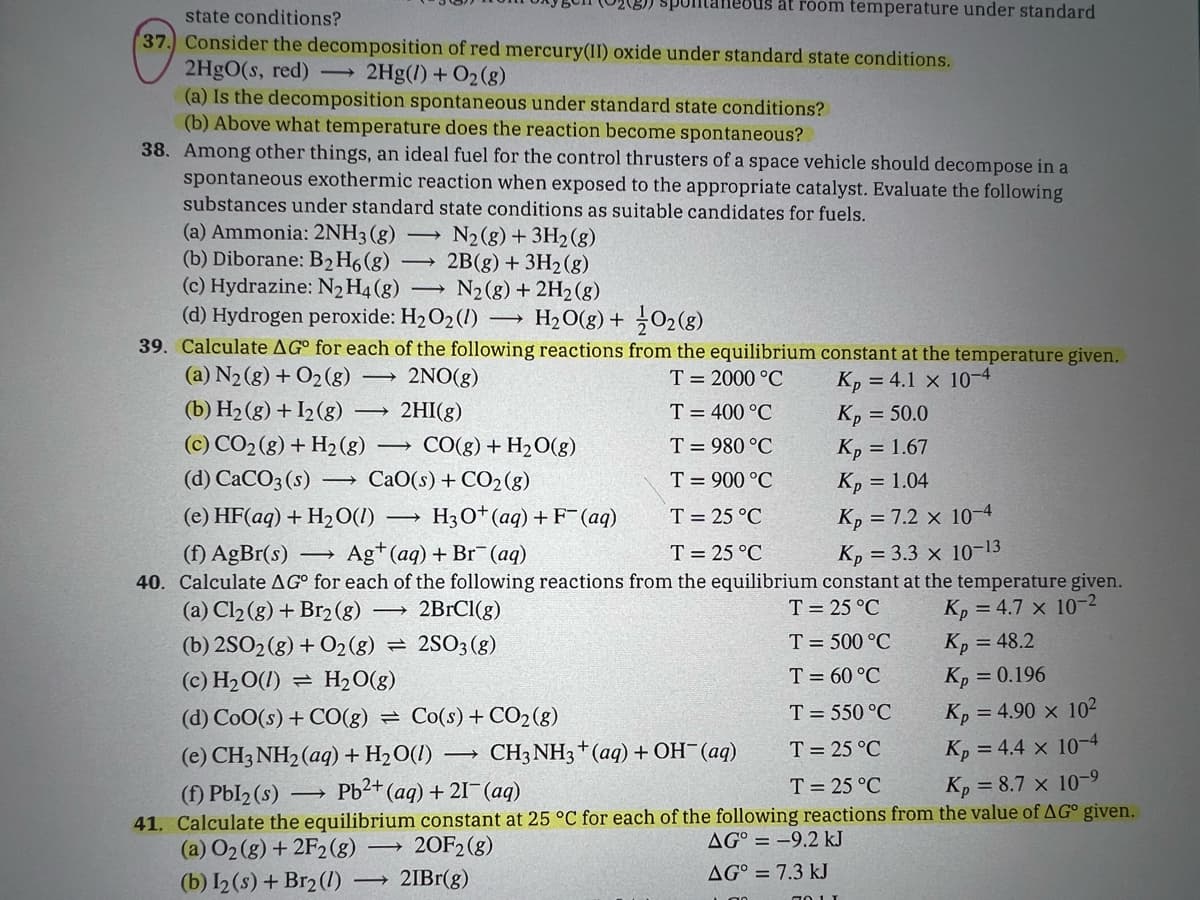39. Calculate AG for each of the following reactions from the equilibrium constant at the temperature given. (a) N₂(g) + O2 (8) → 2NO(g) T = 2000 °C Kp =4.1 × 10-4 (b) H₂(g) + 12 (8) 2HI(g) T = 400 °C Kp = 50.0 (c) CO2 (g) + H₂(g) T = 980 °C Kp = 1.67 (d) CaCO3(s) -> CaO(s)+CO2(g) T = 900 °C Kp = 1.04 T = 25 °C (e) HF(aq) + H₂O(1) -> H3O+ (aq) + F(aq) Ag+ (aq) + Br(aq) (f) AgBr(s) T = 25 °C - - - CO(g) + H₂O(g) Kp = 7.2 × 10-4 Kp = 3.3 × 10-13
39. Calculate AG for each of the following reactions from the equilibrium constant at the temperature given. (a) N₂(g) + O2 (8) → 2NO(g) T = 2000 °C Kp =4.1 × 10-4 (b) H₂(g) + 12 (8) 2HI(g) T = 400 °C Kp = 50.0 (c) CO2 (g) + H₂(g) T = 980 °C Kp = 1.67 (d) CaCO3(s) -> CaO(s)+CO2(g) T = 900 °C Kp = 1.04 T = 25 °C (e) HF(aq) + H₂O(1) -> H3O+ (aq) + F(aq) Ag+ (aq) + Br(aq) (f) AgBr(s) T = 25 °C - - - CO(g) + H₂O(g) Kp = 7.2 × 10-4 Kp = 3.3 × 10-13
Chemistry by OpenStax (2015-05-04)
1st Edition
ISBN:9781938168390
Author:Klaus Theopold, Richard H Langley, Paul Flowers, William R. Robinson, Mark Blaser
Publisher:Klaus Theopold, Richard H Langley, Paul Flowers, William R. Robinson, Mark Blaser
Chapter16: Thermodynamics
Section: Chapter Questions
Problem 63E: One of the important reactions in the biochemical pathway glycolysis is the reaction of...
Related questions
Question
100%
Please help with # 39.
I do not know how to solve

Transcribed Image Text:state conditions?
37. Consider the decomposition of red mercury(II) oxide under standard state conditions.
2HgO(s, red) → 2Hg(1) + O₂(g)
(a) Is the decomposition spontaneous under standard state conditions?
(b) Above what temperature does the reaction become spontaneous?
38. Among other things, an ideal fuel for the control thrusters of a space vehicle should decompose in a
spontaneous exothermic reaction when exposed to the appropriate catalyst. Evaluate the following
substances under standard state conditions as suitable candidates for fuels.
(a) Ammonia: 2NH3(g)
(b) Diborane: B₂ H6 (g)
(c) Hydrazine: N₂ H4 (8)
-
(d) Hydrogen peroxide: H₂O₂ (1)
→
N₂(g) + 3H₂(g)
2B(g) + 3H₂(g)
N₂ (8) + 2H₂(g)
→
39. Calculate AG for each of the following reactions from the equilibrium constant at the temperature given.
(a) N₂(g) + O2 (8)
2NO(g)
T = 2000 °C
(b) H₂(g) + 12 (8)
Kp =4.1 × 10-4
Kp = 50.0
T = 400 °C
T = 980 °C
(c) CO₂(g) + H₂(g) → CO(g) + H₂O(g)
(d) CaCO3(s) ->> CaO(s)+CO2(g)
Kp = 1.67
T = 900 °C
Kp = 1.04
(e) HF(aq) + H₂O(1)
Kp = 7.2 × 10-4
T = 25 °C
T = 25 °C
(f) AgBr(s) → Ag+ (aq) + Br(aq)
Kp = 3.3 X 10-13
40. Calculate AG° for each of the following reactions from the equilibrium constant at the temperature given.
(a) Cl₂(g) + Br₂(g) → 2BrCl(g)
T = 25 °C
Kp=4.7 × 10-2
Kp = 48.2
2SO3 (8)
T = 500 °C
T = 60 °C
Kp = 0.196
T = 550 °C
Kp = 4.90 × 10²
CH3NH3 + (aq) + OH¯ (aq)
T = 25 °C
Kp =4.4 × 10-4
(e) CH3NH₂ (aq) + H₂O(1)
(f) Pbl₂ (s)
T = 25 °C
→ Pb²+ (aq) + 21- (aq)
Kp = 8.7 × 10-9
41. Calculate the equilibrium constant at 25 °C for each of the following reactions from the value of AG° given.
AG = -9.2 kJ
(a) O₂(g) + 2F2 (g) 20F2 (g)
(b) I2 (s) + Br2 (1)
21Br(g)
AG = 7.3 kJ
2HI(g)
→
H₂O(g) + 02 (8)
bus at room temperature under standard
H3O+ (aq) + F(aq)
(b) 2SO2(g) + O2 (8) =
(c) H₂O(l): = H₂O(g)
(d) CoO(s)+CO(g) = Co(s)+CO2(g)
-
Expert Solution
This question has been solved!
Explore an expertly crafted, step-by-step solution for a thorough understanding of key concepts.
Step by step
Solved in 4 steps with 2 images

Knowledge Booster
Learn more about
Need a deep-dive on the concept behind this application? Look no further. Learn more about this topic, chemistry and related others by exploring similar questions and additional content below.Recommended textbooks for you

Chemistry by OpenStax (2015-05-04)
Chemistry
ISBN:
9781938168390
Author:
Klaus Theopold, Richard H Langley, Paul Flowers, William R. Robinson, Mark Blaser
Publisher:
OpenStax

Principles of Modern Chemistry
Chemistry
ISBN:
9781305079113
Author:
David W. Oxtoby, H. Pat Gillis, Laurie J. Butler
Publisher:
Cengage Learning

Chemistry: Principles and Practice
Chemistry
ISBN:
9780534420123
Author:
Daniel L. Reger, Scott R. Goode, David W. Ball, Edward Mercer
Publisher:
Cengage Learning

Chemistry by OpenStax (2015-05-04)
Chemistry
ISBN:
9781938168390
Author:
Klaus Theopold, Richard H Langley, Paul Flowers, William R. Robinson, Mark Blaser
Publisher:
OpenStax

Principles of Modern Chemistry
Chemistry
ISBN:
9781305079113
Author:
David W. Oxtoby, H. Pat Gillis, Laurie J. Butler
Publisher:
Cengage Learning

Chemistry: Principles and Practice
Chemistry
ISBN:
9780534420123
Author:
Daniel L. Reger, Scott R. Goode, David W. Ball, Edward Mercer
Publisher:
Cengage Learning

Chemistry: The Molecular Science
Chemistry
ISBN:
9781285199047
Author:
John W. Moore, Conrad L. Stanitski
Publisher:
Cengage Learning

Chemistry: An Atoms First Approach
Chemistry
ISBN:
9781305079243
Author:
Steven S. Zumdahl, Susan A. Zumdahl
Publisher:
Cengage Learning

Chemistry
Chemistry
ISBN:
9781305957404
Author:
Steven S. Zumdahl, Susan A. Zumdahl, Donald J. DeCoste
Publisher:
Cengage Learning